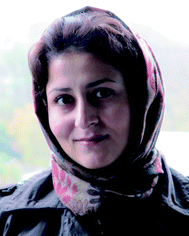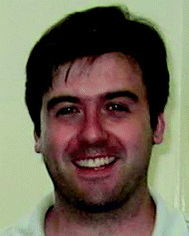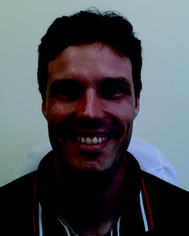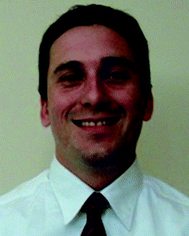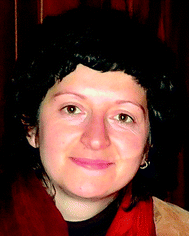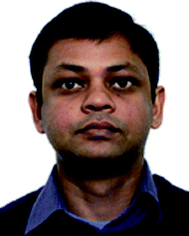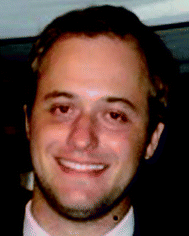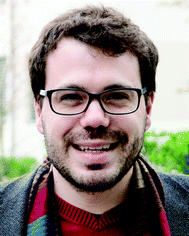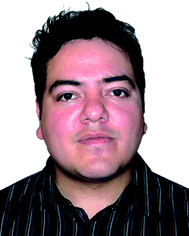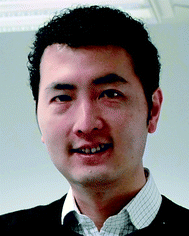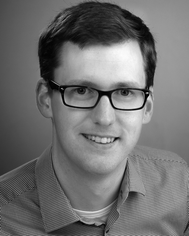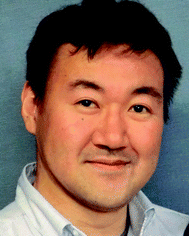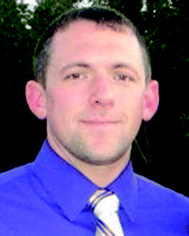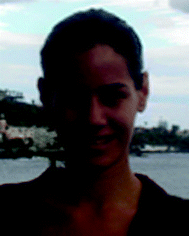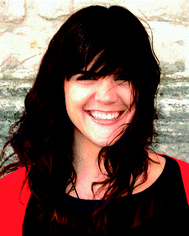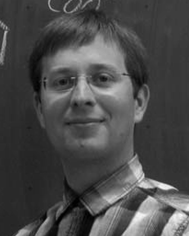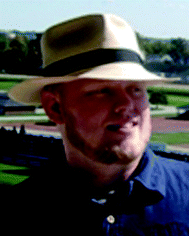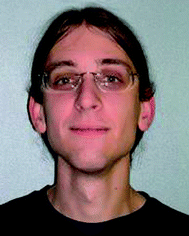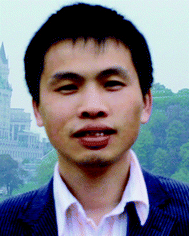Contributors to the Young Analytical Scientists themed issue
Maryam Aghaei was born in Iran in 1982. She grew up in Tehran and got her diploma in Mathematics and Physics at the National Organization for Especial Talents (NOET). She received a national award at the age of 13 for one of her game design programs. She finished her undergraduate studies in Physics at Tehran Polytechnic University. To be closer to applications she chose Photonics for her master study in the Laser and Plasma Research Institute of Shahid Beheshti University in Tehran. With a physics background, and growing up in a computer engineering family, she found her interest in modeling physical phenomena and therefore she did computational work on gas dynamics of plasmas produced by laser ablation. As a result, a thermal model for nanosecond pulsed laser ablation of Cu was developed in Prof. S. H. Tavassoli's group during her thesis. Subsequently, she moved to Belgium and started her PhD in the PLASMANT group under the supervision of Prof. A. Bogaerts in Antwerp. She developed a computational model for an ICP torch coupled to a mass spectrometer and will improve the code in her last year of PhD in order to trace the injected analytes in the torch. By means of computer simulations, she aims to obtain an enhancement insight in ICPMS which hopefully leads to improve the instrument's efficiency. Besides computational work, she wants to keep close to the real world of experimental labs, so she spent some short research stays at Prof. K. Niemax' lab at ISAS in Dortmund, Prof. G. Hieftje's lab at Indiana University in Bloomington and at Prof. D. Günther's lab at ETH in Zurich. Hence, although as a child, she imagined herself in a dark blue overall in a factory with a wrench in oily hands, she is now working in the totally neat and clean environment of software and PCs.Juliano S. Barin is Full Professor of Chemistry at the Universidade Federal de Santa Maria (UFSM), Rio Grande do Sul State, Brazil. He obtained his PhD in Analytical Chemistry at UFSM (2007). Nowadays, he is a member of the Brazilian Pharmacopeia working for the establishment of reference materials and the development of analytical methods (mainly by the use of atomic spectrometric techniques) for quality evaluation of food and pharmaceutical products. He develops projects related to the application of alternative energies (mainly microwaves) in sample preparation in analytical chemistry, instrumentation development and industrial processes. He coordinates projects related to the application of these energies for petrochemical and food industries and works in other projects dealing with industrial processes.
Cezar A. Bizzi is Full Professor of Analytical Chemistry at UFSM, Rio Grande do Sul State, Brazil. He obtained his PhD in Analytical Chemistry at UFSM (2012). His research topics are related to the development of analytical methods for element determination by spectrometric techniques in biological, environmental and petrochemical samples using digestion methods based on microwave and ultrasound.
Daniel L. G. Borges was born in Recife-PE, in the warm and sunny Northeast region of Brazil. He obtained his B.Sc. in Chemistry in 2003, at the Federal University of Santa Catarina (UFSC), in Florianópolis-SC, Brazil, and concluded his doctorate in Analytical Chemistry in 2009 at the same institution, working under the supervision of Dr Bernhard Welz and Dr Adilson Curtius. In 2008, he decided to conduct part of the experiments for his thesis at the National Research Council Canada, in Ottawa, working under the supervision of Dr Ralph Sturgeon, mainly on the topic of organometallic compound analysis using organic mass spectrometry. Following his return to Brazil and the defense of his thesis, he worked for one year as an Assistant Professor at UFSC, whereby he later assumed a permanent position as an Associate Professor, also conducting research projects on the topics of atomic and inorganic mass spectrometry. His current research interests include method development using high-resolution continuum source AAS and ICPMS, with particular focus on the investigation of alternative sample preparation and introduction techniques, the development of novel extraction and preconcentration procedures and the investigation of novel sample introduction devices and ion sources for MS. When not at work, he deeply enjoys spending time with his wife, his son and other relatives. His hobbies include singing and playing acoustic guitar with friends and some outdoor activities, mainly involving playing soccer and basketball with his friends and his students.
Olga Borovinskaya is a PhD student in the research group of Prof. Detlef Günther (Laboratory of Inorganic Chemistry, ETH Zürich). In 2007 Olga graduated from the North-Kazakhstan State University in Kazakhstan with a B.Sc. in Chemistry. Following graduation, she got a unique opportunity to move to Switzerland for an internship and worked in the Laboratory of Air Pollution/Environmental Technology at EMPA (a Swiss research institute of the ETH domain). In 2008 Olga started the Master's program at ETH Zürich, which she completed with the Master's thesis on the topic “Nanoparticle characterization using ICPMS in single particle mode” in the group of Trace Element and Micro Analysis. Due to her great interest in the analysis of nanomaterials by ICPMS developed during her Master's thesis, she decided to devote her doctoral work to this topic. The primary goal of her research focuses on the development and characterization of a new ICPTOFMS with high temporal resolution for the comprehensive characterization of inorganic nanoparticles. In parallel, her current scientific activity has diversified into other exciting topics such as high resolution LA-ICPMS and ICP fundamental processes.
Prasoon Diwakar was born in India in 1979 where he did his undergraduate studies in mechanical engineering at the Indian Institute of Technology, Kanpur. During his undergraduate program, he worked at CNR-TEMPE, Milan, as a summer intern where he studied soot formation in flames using laser diagnostics. His summer stay at CNR-TEMPE motivated him to pursue research work in the field of lasers and spectroscopy. After completing his undergraduate education he moved to the University of Florida, Gainesville, for his Masters and PhD in the Mechanical Engineering department under the guidance of Dr David Hahn. He worked on various projects including combustion and LIBS and was exposed to several analytical techniques which further motivated him to be a researcher in the field of laser diagnostics and analytical chemistry. His PhD dissertation focused on understanding plasma–particle interactions with regards to understanding fundamentals of LIBS for qualitative analysis of aerosols. After completing his PhD from the University of Florida, Prasoon joined the National Institute for Occupational Safety and Health (NIOSH) as a National Research Council postdoc where he worked with Dr Pramod Kulkarni in developing various novel instruments for aerosol detection using plasma based analytical techniques such as LIBS, SIBS and MIPS. Currently he is a postdoctoral research associate at the Centre for Materials under Extreme Environment (CMUXE) at Purdue University and is working on understanding fundamentals of ultrafast laser ablation processes and their implications on various analytical techniques including LA-ICPMS and LIBS. Besides research, Prasoon is also passionate about the cause of providing education for underprivileged children and volunteers with various non-profit organizations in supporting the cause of education.
Fábio A. Duarte is Full Professor of Analytical Chemistry at UFSM, Rio Grande do Sul State, Brazil. He obtained his PhD in Analytical Chemistry at UFSM (2009). His research topics are related to the development of analytical methods for element determination and speciation by spectrometric and chromatographic techniques in biological, environmental and petrochemical samples using digestion methods based on microwave and ultrasound.
Luca Flamigni studied chemistry at the Swiss Federal Institute of Technology (ETH Zurich, Switzerland), where he obtained a Masters Degree in 2009 with a thesis on “nanostructured surfaces as versatile tools for laser desorption/ionization mass spectrometry”. After graduating, he joined the group for micro and trace analysis at the Laboratory of Inorganic Chemistry at ETH Zurich as a PhD student under the guidance of Prof. D. Günther. There he has been working on diagnostic tools to understand the behavior of laser-produced aerosols in inductively coupled plasma sources used for mass spectrometry. Despite his expertise in experimental approaches, he likes to cross the border between empirical and theoretical sciences and to verify the links between experimental findings and computer-aided predictions based on current models. As a result of the time spent with optical imaging systems, Luca has developed a strong interest in the implementation of automated image processing tools for fast and robust data evaluation. Outside the laboratories, Luca enjoys playing the piano, composing music, and cooking.
Gerardo Gamez was born and raised in Cd. Juarez, Mexico. He obtained his Bachelor of Science degree at the University of Texas at El Paso (UTEP), USA, summa cum laude and with Departmental Honors in Chemistry, where he performed research with Prof. Jorge Gardea-Torresdey in the area of Environmental Chemistry pertaining to the use of plant tissues to filter aqueous media from heavy metal contamination. He also performed his Master of Science Thesis work in the Gardea-Torresdey group which pertained to the development of methods to recover noble metals from aqueous media and new processes to produce noble metal nanoparticles. He obtained his PhD in Analytical Chemistry at Indiana University-Bloomington, USA, with Prof. Gary M. Hieftje, where he employed laser and optical emission diagnostic techniques in fundamental studies of plasmas used in analytical spectrochemistry. During this time he obtained the American Chemical Society-Division of Analytical Chemistry fellowship as well as the MERC fellowship. His work on the development of GDOES elemental mapping won him the first Richard Payling Award. He also co-developed a plasma based ambient mass spectrometry source. His postdoctoral work at the Swiss Federal Institute of Technology, ETH Zurich, Switzerland, with Prof. Renato Zenobi, involved developing methods for ambient ionization mass spectrometry and exploring the possibilities of near-field laser ablation techniques. He then worked as a Scientist in the Laboratory for Mechanics of Materials and Nanostructures at the Swiss Federal Laboratories for Materials Science and Technology, EMPA Thun, Switzerland, where he developed methods and instrumentation in glow discharge spectroscopy. In the fall of 2013 he became an Assistant Professor in the Department of Chemistry and Biochemistry at Texas Tech University. He has authored and co-authored more than 50 peer-reviewed publications (h-index 22). In his spare time he enjoys spending time with his family and playing drums.
Kelvin Sze-Yin Leung received his B.Sc. (Hons) and PhD in Chemistry at the University of Hong Kong. He joined the Hong Kong Baptist University as an Assistant Professor in 2008. His broad research interests in analytical chemistry range from the development of sample pretreatment methodology in clinical diagnosis, to the study of pathophysiological distribution of trace elements using mass spectrometric techniques. Kelvin is well-recognized for his effort in coping with complex analytical matrices for clinical samples analysis. Recent major contributions along this line include the studies of early stage disease diagnosis and bioimaging. He has published over 90 research papers.
Björn Meermann was born in Bergisch Gladbach, Germany, in 1982. He studied Chemistry at the University of Münster where he obtained his Diploma in Chemistry in 2006 and his PhD in Analytical Chemistry in 2009 under supervision of Prof. Uwe Karst. His PhD was funded by a scholarship of the German Federal Environmental Foundation (DBU). During his PhD he focused on technical aspects of the hyphenation of several separation systems (capillary electrophoresis, liquid chromatography, thin layer chromatography) to ICPMS for speciation analysis of environmentally relevant species. Afterwards, he worked in Prof. Frank Vanhaecke's group at Ghent University (Belgium) for almost two years as a Post-Doc researcher—funded by a scholarship from the “Deutsche Akademie der Naturforscher Leopoldina”—where he “tasted” from the field of isotope analysis which attracted him. During his stay in Ghent he worked on the topic of speciation analysis of halogen-containing drug metabolites in cooperation with the pharmaceutical industry by means of HPLC/ICPMS making use of species-unspecific post-column on-line isotope dilution for quantification purposes. In 2012 he returned to Germany working at the Federal Institute of Hydrology (BfG) in the group of Prof. Thomas Ternes as a Post-Doc researcher – currently on the topic of nanomaterials. His research interests are still mainly focused on ICPMS analysis and hyphenated techniques for speciation (and fractionation) analysis in combination with on-line isotope dilution and stable isotopes.
Takeshi Ohno graduated from Tokyo Institute of Technology in 2001 and received his PhD in earth and planetary sciences from Tokyo Institute of Technology in 2006. He joined Gakushuin University, Japan in 2011, and has been studying radiochemistry and isotope geochemistry, especially the environmental behavior of radionuclides released by the Fukushima Daiichi Nuclear Power Plant accident. Currently he works as an Assistant Professor in the Department of Chemistry, Faculty of Science. His research interests are focused on the development of mass spectrometric techniques for isotope ratio measurement, and their application to studies on the behavior of radionuclides in the environment.
C. Derrick Quarles Jr., PhD, born in Augusta, Georgia, USA, completed his Bachelors in Chemistry at Augusta State University and received his PhD in Analytical Chemistry under the direction of Dr R. Kenneth Marcus in 2011 from Clemson University. His dissertation work was focused in the area of glow discharge spectroscopy with emphasis in metallomics based applications. He was a guest researcher at the Pacific Northwest National Laboratory as well as the Lawrence Berkeley National Laboratory in 2011. After that he had a Fellowship with the Centers for Disease Control and Prevention in Atlanta, Georgia, from 2011–2013 as a chemist in the Inorganic and Radiation Analytical Toxicology Branch. His responsibilities included the use of ICPMS for toxic metals analysis in biological matrices. Recent adventures have taken him to California where he has joined the scientific team at Applied Spectra Inc. working with LIBS and LA-ICPMS. His new position as an Application Scientist focuses on the development of new instrumentation and methods as well as sharing this knowledge with LIBS and LA users around the world.
Lara Lobo Revilla was born in 1982 in Santander (Cantabria, Spain). She studied Chemistry at the University of Oviedo, where she also started her PhD in 2006. The subject of her work was the instrumental development and analytical applications of a new instrument based on GD-TOFMS. She also worked with SIMS during a research stay at the group of Prof. Antonino Licciardello at the University of Catania, Italy. Under the supervision of Prof. Rosario Pereiro and Dr Nerea Bordel, she obtained her PhD degree in 2011 and was given the Extraordinary Doctorate Award (Physical and Analytical Chemistry) of the University of Oviedo. The same year she got a IEF Marie-Curie Fellowship and joined the A&MS group of Prof. Frank Vanhaecke in the Analytical Chemistry Department at Ghent University, Belgium. Her current research mainly deals with isotopic analysis for provenancing ancient glass.
Raquel Sánchez-Romero was born in Alicante, Spain, in 1983. She obtained her graduate in Chemistry at the University of Alicante in 2007. At that time, she joined the Analysis of Polymers and Nanomaterials group at the Department of Analytical Chemistry, Nutrition and Food Sciences of the University of Alicante. She obtained her PhD under the supervision of Prof. José Luis Todolí (University of Alicante) and Dr Charles-Philippe Lienemann (IFP-Energies Nouvelles, Lyon, France). During this period, she was granted by the University of Alicante in collaboration with the IFP-Energies nouvelles. Part of her PhD work was carried out in the IFP-Energies nouvelles. Her work was focused on the development and evaluation of new methods for fuel analysis based on the use of ICP-AES. With this aim, fundamental studies on the effects of the chemical form of analyte on the emission intensity and on matrix effects were performed and alternatives to traditional methods for mitigating these unwanted effects were proposed. The main gain was the mitigation of matrix effects by a method based on the employment of a 350 °C heated single pass spray chamber following a segmented flow injection methodology for the analysis of petroleum products through ICP-AES. Her first publication, a study of the effect of the silicon chemical form on the emission intensity in ICP-AES for xylene matrices, was highlighted on the inside front cover of JAAS in 2009. During that time, she also collaborated with other projects focused on the characterization of environmental samples and pharmaceuticals products. Since March 2012, she has a postdoctoral fellowship at the Institute for Reference Materials and Measurements, Joint Research Center, European Commission (Geel, Belgium) working as a project manager for the development, the production and the validation of certified reference materials in environmental science. She is co-author of six publications and one book chapter. Moreover, she has provided twenty one contributions at national and international conferences.
Gunnar Schwarz was born in 1983 in Berlin, Germany. After studying chemistry at the Humboldt-Universitaet zu Berlin, he worked for his diploma thesis at the Federal Institute for Materials Research and Testing (BAM) in the group of Dr Win Tin under guidance of Prof. Irene Nehls in 2008. In 2009 for his PhD, he joined the Applied Analytical and Environmental Chemistry group of Prof. Michael W. Linscheid at the Department of Chemistry of the Humboldt-Universitaet zu Berlin. His research interests lie in the development and implementation of metal labeling tools that utilize DOTA chelate complexes for protein quantification. Furthermore, he is dedicated to teaching analytical chemistry in terms of exercises for students and lectures for pupils. Among research and teaching he likes to ride his bicycles.
Jacob Shelley was born in Albuquerque, New Mexico, USA, in 1984. He earned his B.Sc. in Chemistry from Northern Arizona University in Flagstaff, Arizona in 2005. Jake completed his PhD at Indiana University under Prof. Gary Hieftje in 2011 where his research focus was on the plasma ionization sources for ambient mass spectrometry. Jake started his postdoctoral research with Prof. R. Graham Cooks at Purdue University in 2011 where he developed portable mass spectrometers capable of in situ analyses. In 2012, Jake started his second post-doctoral stint with Dr Carsten Engelhard at the University of Münster where he was awarded a prestigious Alexander von Humboldt Fellowship. In 2014, Jake became an Assistant Professor at Kent State University. His current research interests lie in the area of fundamental characterization of plasma-based ionization methods and expanding the capabilities of such sources.
Helmar Wiltsche received his PhD from the Graz University of Technology in 2008 for his work on the analysis of trace contaminants in highly alloyed steels and super alloys. As a postdoc at the ETH Zurich, Laboratory of Inorganic Chemistry, Zürich, Switzerland, he focused his research interests on fundamental studies as well as application of LA-ICPMS. From 2010 on, he is group leader of the Elemental Analysis and Applied Spectrometry group at the Institute of Analytical Chemistry and Food Chemistry, Graz University of Technology, Austria. His research interests include fundamental investigations of the ICP as excitation and ionization source, development of new systems and procedures for the sample digestion and construction and evaluation of new ICP interfaces.
Chengbin Zheng obtained his B.Sc. in chemistry and PhD in environmental science from Sichuan University, China, in 2002 and 2007, respectively, under the supervision of Prof. Xiandeng Hou, and was retained as a lecturer in the College of Chemistry. In 2008–2009, he moved to Ottawa to work with Dr Ralph E. Sturgeon as a postdoctoral researcher at the Institute for National Measurements Standards, Canada, where he realized highly sensitive determination of Fe, Co, Ni, Cu and I by vapor generation. Currently he is a Professor at Sichuan University and focuses his research interests on using vapor generation techniques and/or nanomaterials for determination of toxic elements in environmental samples. He has published fifty papers in peer-reviewed international journals.
| This journal is © The Royal Society of Chemistry 2014 |

